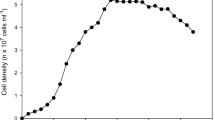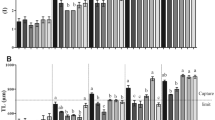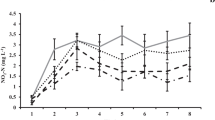Abstract
This study was carried out to evaluate the population growth and egg ratio of Brachionus rotundiformis by feeding with three different diets, i.e., live microalgae Nannochloropsis sp., Baker’s yeast, and powdered spirulina. A total of nine conical flasks of 1 L volume were divided into three treatment groups for determining the feeding performance for eight consecutive days. Each experimental group was stocked with B. rotundiformis at an initial density of 10 ind. mL−1. Water temperature, pH, salinity, and light were maintained at (24–29) °C, (7.5–8.5), 30 ppt, and 4000 lx, respectively. Feed was provided twice per day at 9:00 AM and 7:00 PM. The highest mean (±SE) population growth of rotifer was achieved at the end of the culture period (on the 8th day) fed live Nannochloropsis sp. (122 ± 12 ind. mL−1), which was significantly higher compared to the Baker’s yeast and powdered spirulina (p < 0.05). The mean egg ratio of B. rotundiformis fed three diets was significantly differ at different rearing periods (p > 0.05). The highest mean (±SE) egg ratio of B. rotundiformis was observed in the live Nannochloropsis fed group (0.89 ± 0.01) at the end of the rearing period, which was significantly higher than that of Baker’s Yeast and powdered Spirulina fed group (p < 0.05). Among the three diets, live Nannochloropsis had shown the dietary superiority over Baker’s yeast and powdered spirulina in culturing B. rotundiformis. The results of this study suggest that live Nannochloropsis could be the most suitable diet for the laboratory culture of B. rotundiformis.




Similar content being viewed by others
References
Agbon AO, Ofojekwu PC, Ezenwaka IC, Alebeleye WO (2002) Acute toxicity of diazinon on rotifers, Cyclops, mosquito larvae and fish. J Appl Sci Environ Manag 6(1):18–21
Alam MJ, Shah MMR (2004) Growth and reproductive performance of locally isolated brackish water rotifer (Brachionus plicatilis) feeding different micro algae. Bangladesh J Fish Res 8(2):127–133
Arimoro FO, Ofojekwu PC (2004) Some aspects of the culture, population dynamics and reproductive rates of the freshwater rotifer, Brachionus calyciflorus fed selected diets. J Aquat Sci 19(2):95–98
Clément P, Wurdak E (1991) Rotifera. In: Harrison FW, Ruppert EE (eds) Microscopic anatomy of invertebrates, Vol. 4, Ascheleminthes. Wiley-Liss, New York, pp 219–297
Edmondson WT (1960) Reproductive rates of rotifers in natural populations. Memorie dell’Istituto Italiano di Idrobiologia Dott. Marco de Marchi 12:21–77
FAO (2018) The state of world fisheries and aquaculture 2018 - meeting the sustainable development goals. Rome, pp. 227
Fukusho K (1989a) Biology and mass production of the rotifer Brachionus plicatilis. Int J Aquacult Fish Technol 1:232–240
Fukusho K (1989b) Biology and mass production of the rotifer Brachionus plicatilis. Int J Aquacult Fish Technol 1:292–299
Fulks F, Main KL (1991) Rotifer and microalgae culture systems. Proc. US–Asia Workshop, Oceanic Insitute, Honolulu, HI, pp. 364
Guiry MD, Guiry GM (2020). AlgaeBase. Worldwide electronic publication, National University of Ireland, Galway. https://www.algaebase.org; searched on 17 June 2020
Hagiwara A, Balompapueng MD, Munuswamy N, Hirayama K (1997) Mass production and preservation of the resting eggs of the euryhaline rotifer Brachionus plicatilis and B. rotundiformis. Aquaculture 155:223–230
Hagiwara A, Gallardo WG, Assavaaree M, Kotani T, De Araujo AB (2001) Live food production in Japan: recent progress and future aspects. Aquaculture 200(1–2):111–127
Hirata H, Yamasaki S, Kawaguchi T, Ogawa M (1983) Continuous culture of the rotifer Brachionus plicatilis fed recycled algal diets. Hydrobiologia 104(1):71–75
Hoff FH, Snell TW (1989) Plankton culture manual. Florida Aqua Farms, Inc., p 126
Hoff FH, Snell TW (2001) Plankton culture manual (5th edition, 2001). Florida aqua farms, Inc. Florida, USA. ISBN 0-9662960-0-1
Howell BR (1973) Marine fish culture in Britain. VIII. A marine rotifer, Brachionus plicatilis Miiller, and the larvae of the mussel, Mytilus edulis L. as foods for larval flatfish. J Cons Int Explor Mer 35:1–6
Ito T (1960) On the culture of the mixohaline rotifer Brachionus plicatilis of Muller in seawater. Report of the Faculty of Fisheries, Prefectural University of Mie, 3:708–740
James CM, Bou-Abbas M, Al-Khars AM, Al-Hinty S, Salman AE (1983) Production of rotifer Brachionus plicatilis for aquaculture in Kuwait. Hydrobiologia 104:77–84
Khatun B, Rahman R, Rahman MS (2014) Evaluation of yeast Saccharomyces cerevisiae and algae Chlorella vulgaris as diet for rotifer Brachionus calyciflorus. Agriculturists 12(1):1–9
Liao IC, Su HM, Chang EY (2001) Techniques in finfish larviculture in Taiwan. Aquaculture 200:1–32
Lubzens E (1987) Raising rotifers for use in aquaculture. Hydrobiologia 147:245–255
Lubzens E (2001) Biotechnology and aquaculture of rotifers. Hydrobiologia 446/447(1):337–353
Mills S, Alcántara-Rodríguez JA, Ciros-Pérez J, Gómez A, Hagiwara A, Galindo KH, Jersabek CD, Malekzadeh-Viayeh R, Leasi F, Lee JS, Welch DBM, Papakostas S, Riss S, Segers H, Serra M, Shiel R, Smolak R, Snell TW, Stelzer C, Tang CQ, Wallace RL, Fontaneto D, Walsh EJ (2017) Fifteen species in one: deciphering the Brachionus plicatilis species complex (Rotifera, Monogononta) through DNA taxonomy. Hydrobiologia 796(1):39–58
Mostary S, Rahman MS, Hossain MA (2007) Culture of rotifer Brachionus angularis Hauer feeding with dried Chlorella. Univ J Zool Rajshahi Univ 26:73–76
Oie G, Reitan KI, Olsen Y (1994) Comparison of rotifer culture quality with yeast plus oil and algal-based cultivation diets. Aquac Int 2:225–238
Ortega-Salas AA, Reyes CI, Reyes-Bustamante H (2014) Population growth and cyst production of the rotifer Brachionus plicatilis (Monogonta: Brachionidae) fed with three different diets. UNED Research Journal/Cuadernos de Investigación UNED, 5(2):195–199
Ruttner-Kolisko A (1974) Planktonic rotifers: biology and taxonomy. Die Binnengewässer (Suppl) 26:1–146
Sahandi J, Jafaryan H (2011) Rotifer (Brachionus plicatilis) culture in batch system with suspension of algae (Nannochloropsis oculata) and bakery yeast (Saccharomyces cerevisiae). Aquac Aquar Conserv Legis 4(4):526–529
Sarma SSS, Rao TR (1987) Effect of food level on body size and egg size in a growing population of the rotifer Brachionus patulus Muller. Arch Hydrobiol 111:245–253
Sharma JG, Masuda R, Tanaka M, Chakrabarti R (2018) The continuous culture of rotifer Brachionus plicatilis with sea water. Madridge J Aquac Res Dev 2(1):40–42
Snell TW, Childress MJ, Boyer EM, Hoff FH (1987) Assessing the status of rotifer mass cultures. J World Aquacult Soc 18(4):270–277
Sulehria AQK, Abrar J, Shah AH, Malik MA (2015) Effect of algae and other food types on population growth of rotifers. Biologia 61(2):263–270
Tacon AG, Metian M (2015) Feed matters: satisfying the feed demand of aquaculture. Rev Fish Sci Aquac 23(1):1–10
Tacon AG, Hasan MR, Metian M (2011). Demand and supply of feed ingredients for farmed fish and crustaceans: trends and prospects. FAO fisheries and aquaculture technical paper no. 564. FAO, pp. 87
Theilacker GH, Kimball AS (1984) Comparative quality of rotifers and copepods as foods for larval fishes. CalCOFI Rep 25:80–86
Walne PR (1974) Culture of bivalve molluscs, 50 years experience at Conway. Fishing news (books) ltd., pp 1-173
Watanabe T, Kitajima C, Fujita S (1983) Nutritional values of live organisms used in Japan for mass propagation of fish: a review. Aquaculture 34:115–143
Yoshimatsu T, Hossain MA (2014) Recent advances in the high-density rotifer culture in Japan. Aquac Int 22(5):1587–1603
Acknowledgements
The study was supported by the Research Cell, Research and Publication Office, University of Chittagong, Chattogram 4331, Bangladesh.
Author information
Authors and Affiliations
Contributions
Experimental design: JD, MSH; Experiment conduct: JD, MSH, JH; Data analysis: MAMS, MAMS; Manuscript writing: JD, MSH, JH, and MAMS; Reviewing and Validation: JD and MAMS.
Corresponding author
Ethics declarations
Conflict of Interest
All authors declare no conflicts of interest. All authors listed in the manuscript contributed and attested to the validity and legitimacy of the data and its interpretation and agreed to its submission to your journal.
Data Availability Statement
All data analyzed during this study will be included in this published article.
Additional information
Publisher’s Note
Springer Nature remains neutral with regard to jurisdictional claims in published maps and institutional affiliations.
Rights and permissions
About this article
Cite this article
Das, J., Hossain, M.S., Hasan, J. et al. Growth Performance and Egg Ratio of a Marine Rotifer Brachionus rotundiformis Fed Different Diets in Captivity. Thalassas 37, 113–118 (2021). https://doi.org/10.1007/s41208-020-00261-5
Received:
Revised:
Accepted:
Published:
Issue Date:
DOI: https://doi.org/10.1007/s41208-020-00261-5




